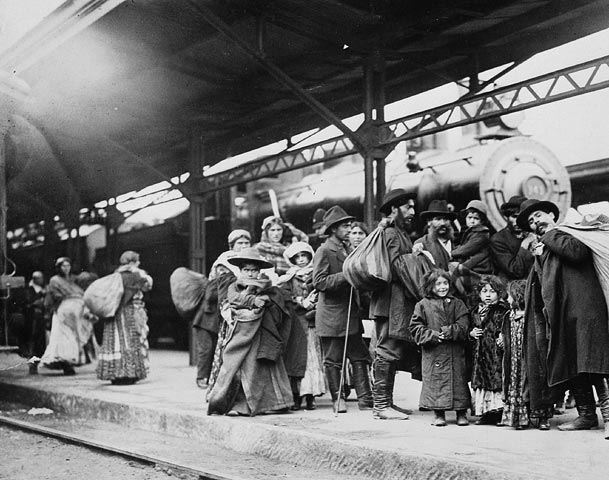Top 10 Pros and Cons of Immigration

The choice whether or not to pick up your family and immigrate to another country is a big decision indeed. Weighing that question of whether or not to immigrate—or, on the flip side of things, how you as a natural-born citizen of a country should feel about immigration—is a complex one indeed. Here are just a few of the pros and cons of each respective position to help you ponder one of the great social phenomena of our time.
The choice whether or not to pick up your family and immigrate to another country is a big decision indeed.
In related news, Arizona is hot, Newfoundland is cold, Macbeth was a little power hungry, and the Maple Leafs have been a little bit unlucky since 1967.
In all seriousness, though, weighing that question of whether or not to immigrate—or, on the flip side of things, how you as a natural-born citizen of a country should feel about immigration—is a complex one indeed. Here are just a few of the pros and cons of each respective position to help you ponder one of the great social phenomena of our time.
Pro: Tradition
There’s no more time-honored social tradition for nations like the United States and Canada than immigration. Both are nations founded on immigration, and the virtues, values, and social fabric of both nations have been woven by a continuing stream of immigrants. Everything from our music, laws, sports, businesses and beer—both Canadian fresh and Coors swill—can either trace their roots to or have otherwise been influenced by immigrants.
If you’re looking to immigrate somewhere, both the US and Canada are fantastic choices with a long history of—eventually—accepting immigrants (more on that in a bit.)
Some countries have more of a history of immigration than others, and some nations, for a variety of reasons, prefer a more homogeneous population to the wonderful multicultural mixing that immigration allows. Thankfully, the US and Canada have historically stood at the forefront of the immigration game.
After all, after all these years, how do immigrant-built nations such as the US and Canada still continue to attract the best talent, grow culturally and, yes, keep their balance?
That we can tell you in one word—Tradition!
Con: Tradition
The Only One Barred Out [Public Domain]
On the other hand, as alluded to above, it’s not as if every immigrant story’s always been a smooth one. Immigration and multiculturalism are wonderful things, but to pretend that each and every story of immigration to Ellis Island was filled with sunshine and rainbows would be just that—pretending. America has a long and proud history of immigration…and an equally-long and not-so-proud history of often being less than receptive towards immigrant groups when they first arrive. To be fair, this has far and away been more of a problem for the United States than Canada.
In the US’s defense, it’s received record numbers of immigrants from around the world, and whether you’re talking about 1918 or 2018 New York, more immigrants means more competition for jobs, and thus more pressure on and potentially-less immediate acceptance of immigrants. By comparison, Canada is…well, just more polite—but then, everyone’s more polite than NYC, and New Yorkers wouldn’t have it any other way.
That question of “tradition” cuts both ways as well. For as easy as it is to dismiss bigots who fear immigrants will somehow “corrupt” a native culture, there’s no denying that immigration has a cultural effect on those doing the immigrating as well. The age-old trope of immigrant children vs. immigrant parents is well-worn, but well-earned as well. Children of Jewish and Italian Immigrants to America in the early 1900s often had an easier time assimilating than did their parents, as reflected by two of baseball’s great Hall of Fame names—Hank Greenberg of the Detroit Tigers and, of course, Joltin’ Joe DiMaggio of the New York Yankees.
While this is a centuries-old cycle has affected the US and Canada alike, one potential answer to that question of tradition reveals itself in the aforementioned example. In the 20th century, a group’s having stars and acceptance in baseball was often a prelude to greater cultural acceptance within the US and Canada, such was the love for the game.
Sports, social media, film, TV, literature, music—there are more outlets than ever for first-generation children of immigrants to find acceptance in US and Canadian society while still holding on to the traditions they and their own native culture hold so dear.
Pro: Little Italy/Poland/Havana/Etc.
Little Italy by Alain Rouiller / Wikimedia Commons / CC BY-SA 2.0
But suppose that’s not quite enough for you. Sure, being accepted is all well and good, but you’ve just left your homeland, and you’re likely to miss.
Chinatown by Hinto / Wikimedia Commons / CC BY-SA 3.0
The West Coast of Canada is a haven for Asian-Canadian culture, with Vancouver itself being one of the great bastions of Asian culture in the Pacific Northwest. If you’re looking to immigrate to North America, Vancouver, the Greater Victoria area, Seattle and San Francisco represent a kind of “Big Four,” and are all well worth your consideration, as they’re rich both in terms of its Asian-American/Canadian culture as well as the numerous tech industries that have taken root in the region.
Bank of Canton by Thomas / Wikimedia Commons / CC BY-SA 3.0
“Chinatowns” have popped up all across the United States, perhaps most famously in San Francisco, while the Los Angeles/Pasadena area is proud to be home to the United States’ most famous Koreatown. In addition, the greater Glendale/Pasadena area has proven to be a wonderful enclave for a significant portion of the Armenian-American population who, since the Diaspora following the unspeakable crime of the Armenian Genocide in 1917, have immigrated to a variety of different areas, including the United States, Lebanon, and areas of Eastern Europe. Finding that middle ground between total cultural assimilation and an inability to mesh with the surrounding socio-political US/Canadian society is a fine line to walk, and these types of areas can prove to be a definite plus when it comes to both celebrating and growing one’s old culture while adapting to another.
Con: “The Lower Eastside”
135 Bowery by Beyond My Ken / Wikimedia Commons / CC BY-SA 4.0
That being said, there’s possibility of those areas being less than kosher, if you get our drift. New York’s fabled “Lower Eastside” was a tough area for Italian, Jewish, Greek, Polish, and other Ellis Island-era immigrants—and arguably still is. Whenever you have a sub-community made up of a largely-immigrant class, the risk is always there for that area to become impoverished, dangerous, or otherwise unfavorable for new immigrants. The onus is on state and national leaders to ensure this sort of thing does not persist, and that’s an area in which Canada excels.
Pro: Economic Opportunity
“The Land of Opportunity” [Public Domain]
We’ve all heard America described as such at one time or another—and isn’t that what we’re all looking for, opportunity?
From the Biblical description of the Land of Israel as one of “milk and honey” to John Steinbeck’s lush descriptions of Central California’s incredibly-fertile and fruitful fields in The Grapes of Wrath, people often go where the money goes, just as the Joad family does in the novel, traveling from their native Dust Bowl-stricken Oklahoma to what they hope will be greener pastures—literally and figuratively—in California. With New York City arguably the financial capital of the world, and Los Angeles, Toronto, and the tech-heavy Pacific Northwest not too far behind, there’s still plenty of “green” to be had by immigrating to North America. Really, everyone wants just a little bit more hope in their life, so much so that the promise of “Hope” has both won over masses and likewise won entire Presidential elections.
Immigration can be a great way to find a new “Land of Opportunity” for you and your family.
Con: Economic Difficulty
Take Steinbeck’s aforementioned novel, written and set at the height of the Great Depression—the Joad’s journey across half of America didn’t end with them finding the opportunity they were looking for, but rather discrimination, hardship, poverty, and an economic system both staggered against them and thousands like themselves looking for that same glimmer of hope and instead finding abject disappointment (or, worst, Bakersfield, California!)
Latinos in the American Southwest are facing a similar struggle today, crossing the border for jobs and sometimes finding a similar brand of wanton hostility and economic disparity.
While the US gets the headlines for economic difficulties, Canada, unfortunately, isn’t immune either. The Rust and Corn Belts of the US extend, to varying extents, into Canada, and while neither Canada nor the US have seen manufacturing or agricultural sectors hit quite as badly as in Steinbeck’s day, given that was the Great Depression, that’d be rather hard to top, and the Recession has hurt those areas.
The US and Canada remain two of the most vibrant economies in the world—it’s just important to remember that not everything is ever wholly “milk and honey” when it comes to immigration.
Pro: Multiculturalism
Statue by Robert Taylor / Wikimedia Commons / CC BY 2.0
One of the most beautiful aspects of our particular age is multiculturalism, and since the dawn of the 1900s especially, it’s been a particular strength of the US and Canada.
For example, consider Haider, an Indian adaptation of Hamlet, a play written by an Englishman that’s to be released to American and international cinemas.
Multiculturalism can rekindle that “muse of fire” and allow it to once again “ascend the brightest heaven of invention”—taking the US and Canada to the top along with it.
The US and Canada were both forged in the crucible of that ascendant, pioneering fire—immigration and the multiculturalism it brings can keep that proud spark aflame.
Con: Globalized Economies
Globalization by Pascal Kirchmair / Wikimedia Commons / CC BY-SA 3.0
While globalized economies can and in many ways have been good for overall economic growth, it can also hurt local economies in the short term. After all, why pay a manufacturing center in Detroit or Toronto when manufacturing costs in nations like Myanmar, China and India are even lower, and unions are either incredibly weak or non-existent? You may wish to take the high road and insist that you won’t pay for goods manufactured in sweatshop conditions, but most people won’t, thus hurting the local economies in the US, Canada, and other similar nations. Why raw goods from in California or Winnipeg when you can buy those same goods can be harvested for cheaper rates in other countries?
All in all, however, it must said that immigration is overwhelmingly a positive force in the world, especially for nations such as the United States and Canada. One of the testaments of any free nation is the capacity and desire to spread and share that spirit of freedom with others, and so that pioneering immigrant spirit should be encouraged at every turn—it shaped the US and Canada as much as anything else, and will continue to serve as one of our great shared strengths well into this new century.
![The only one barred out By Frank Leslie's illustrated newspaper, vol. 54 (1882 April 1), p. 96. [Public domain], via Wikimedia Commons](https://upload.wikimedia.org/wikipedia/commons/thumb/f/f1/The_only_one_barred_out_cph.3b48680.jpg/442px-The_only_one_barred_out_cph.3b48680.jpg)
![Toronto's Little Italy By Alain Rouiller (Toronto Little Italy 7 Uploaded by russavia) [CC-BY-SA-2.0 (https://creativecommons.org/licenses/by-sa/2.0)], via Wikimedia Commons](https://upload.wikimedia.org/wikipedia/commons/thumb/2/22/Toronto_Little_Italy_7_%288437367785%29.jpg/360px-Toronto_Little_Italy_7_%288437367785%29.jpg)




![Monument to Multiculturalism outside of Union Station By Robert Taylor from Stirling, Canada (Union2) [CC-BY-2.0 (https://creativecommons.org/licenses/by/2.0)], via Wikimedia Commons](https://upload.wikimedia.org/wikipedia/commons/thumb/e/e0/Statue_outside_Union_Station.jpg/437px-Statue_outside_Union_Station.jpg)
